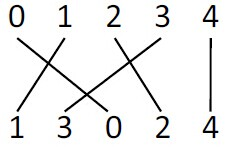
| Online Judge | Online Exercise | Online Teaching | Online Contests | Exercise Author |
|
F.A.Q Hand In Hand Online Acmers |
Best Coder beta VIP | STD Contests DIY | Web-DIY beta |
Little Pony and Boast Busters
Time Limit: 20000/10000 MS (Java/Others) Memory Limit: 131072/131072 K (Java/Others)Total Submission(s): 247 Accepted Submission(s): 109
Problem Description
"I hereby challenge you, Ponyvillians: anything you can do, I can do better. Any takers? Anyone? Or is Trixie destined to be the greatest equine who has ever lived!?!" ¡ª "Boast Busters"
Given two permutation P0 && P1 of {0, 1, ..., n - 1}, we define the crossing number of it as follows. Write P0 from left to right above P1 and draw a straight line between each same elements. The crossing number of P0 and P1 is the number of pairs of lines that cross.
For example, if n = 5, and P0 = {0, 1, 2, 3, 4}, and P1 = {1, 3, 0, 2, 4}, then the crossing number of P0 and P1 is 3, as shown in the figure below.

Now given you the two permutation, you need to implement the following operations:
SWAP p a b: swap Pp[a] and Pp[b] (0<=p<=1, 0<=a, b<=n-1).
QUERY: ask the crossing number of the current P0 and P1.
Given two permutation P0 && P1 of {0, 1, ..., n - 1}, we define the crossing number of it as follows. Write P0 from left to right above P1 and draw a straight line between each same elements. The crossing number of P0 and P1 is the number of pairs of lines that cross.
For example, if n = 5, and P0 = {0, 1, 2, 3, 4}, and P1 = {1, 3, 0, 2, 4}, then the crossing number of P0 and P1 is 3, as shown in the figure below.

Now given you the two permutation, you need to implement the following operations:
SWAP p a b: swap Pp[a] and Pp[b] (0<=p<=1, 0<=a, b<=n-1).
QUERY: ask the crossing number of the current P0 and P1.
Input
Input contains multiple test cases (less than 10). For each test case, the first line contains one integer n (1<=n<=10^5).
The second line contains n integers P0[0], P0[1], ..., P0[n-1].
The third line contains n integers P1[0], P1[1], ..., P1[n-1].
The next line contains one integer q ¡ª¡ª the number of operations (1<=q<=10^5). The next q line, each line will contains a operation as we mentioned above.
The second line contains n integers P0[0], P0[1], ..., P0[n-1].
The third line contains n integers P1[0], P1[1], ..., P1[n-1].
The next line contains one integer q ¡ª¡ª the number of operations (1<=q<=10^5). The next q line, each line will contains a operation as we mentioned above.
Output
For each query, output the corresponding result in one line.
Sample Input
5 0 1 2 3 4 1 3 0 2 4 5 QUERY SWAP 1 2 4 QUERY SWAP 0 2 4 QUERY
Sample Output
3 6 5
Source
| Home | Top |
Hangzhou Dianzi University Online Judge 3.0 Copyright © 2005-2024 HDU ACM Team. All Rights Reserved. Designer & Developer : Wang Rongtao LinLe GaoJie GanLu Total 0.000000(s) query 1, Server time : 2024-11-22 11:41:34, Gzip enabled |
Administration |